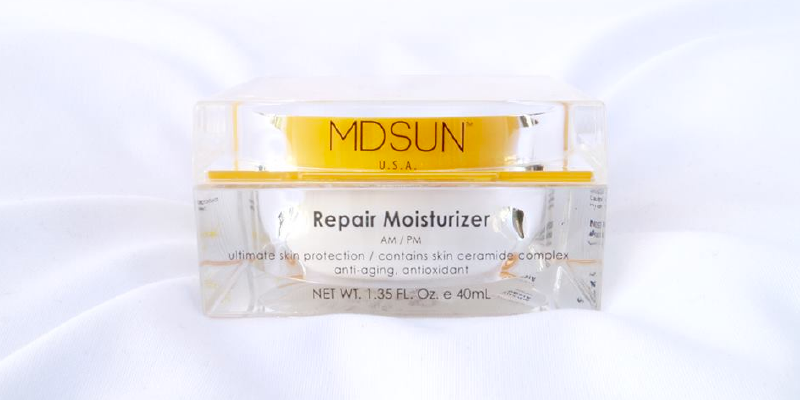Skincare Tips from MDSUN Skin Care®

The skin is a large, complex and important part of the body. It protects the body from disease agents that are constantly trying to enter and physical forces that stress its integrity. Without the skin, the rest of our body’s organs would not last long. In fact, our skin is our body’s number one line of defense against anything in the outside world that might harm our health.
If you have yet to read parts one and two of this mini-series, it might be best to do some backtracking to better understand the information in this post.
The skin as a protective barrier

The skin works very hard to protect our bodies, but external forces can impact the skin’s condition and impair its ability to defend. It can become dry and sensitive when its protective barrier is compromised. A careful skincare routine, using products that work to maintain the optimal pH will make the skin more resilient and less sensitive to the myriad external forces working against it.
How does the skin work to protect us?
The skin consists of three main layers that can be subdivided. From outer to inner, they are the epidermis, the dermis, and the subcutis. The external layer of the epidermis is the stratum corneum, also referred to as the horny layer of the skin. It is made up of dead skin cells (corneocytes) embedded in epidermal lipids and covered by the hydrolipid film. All of these layers work together to create some of the skin’s most important protective abilities.
The epidermis is a very active structure. When the skin is repeatedly exposed to certain stresses, the horny layer thickens to defend the tender interior. For example, calluses form on hands or feet that are exposed to repeated rubbing. If an irritant or infectious agent passes this first line of defense, the skin’s immune system reacts to neutralize the threat. Cellular mechanisms are in place to regenerate and repair stressed and wounded skin. The lower layers of the epidermis are also responsible for the production of vitamin D, which protects us from the disease rickets, a bone disorder. Aspects of the epidermis regulate water movement out of the skin. Trans-epidermal water loss is referred to as TEWL.
The other two layers of the skin, the dermis, and the subcutis also contribute to the skin’s protective barrier. The main structural components of the dermis are collagen and elastin, connective tissues which give strength and flexibility and are the vital components of healthy, young-looking skin. These fibers are embedded in a gel-like substance, which has a high capacity for water-binding and helps to maintain the volume of our skin. Lifestyle and external factors such as solar radiation and changes in temperature have an impact on collagen and elastin levels and on the structure of the surrounding substance. The dermis’ thick, firm texture helps to cushion external blows and, when damage occurs, it contains connective tissues such as fibroblasts and mast cells that heal wounds. It is also rich in blood vessels that nourish the epidermis while removing waste.

The innermost layer of skin is the subcutis, also known as the hypodermis. This layer pads and insulates the body. It is the site of both fat and water storage.
The sebaceous glands deliver sebum or oil to the surface of the skin and the sweat glands deliver water and lactic acid. Both types of glands are located in the dermis. These fluids combine on the stratum corneum to create the hydrolipid film which covers the entire surface of the skin and is very important to the skin’s barrier function. It defends the skin against harmful bacteria and helps the skin to retain moisture and stay hydrated.
While we know there is a bountiful amount of harmful bacteria in the world adversely affecting our skin, there are also helpful bacteria known as microflora. Large numbers of microbes naturally reside on the skin’s surface. Any healthy person at a given time has millions of bacteria living on the surface of the skin, on the mucous membranes of the nose and mouth and the face. Beneficial bacteria may make the skin inhospitable to pathogens or they may trigger an immune response that prevents the growth of harmful bacteria. The bacteria of the microflora work in synergy to create another aspect of the skin barrier defense.
How to protect the skin’s natural defenses?

Healthy lifestyle choices and a regular skincare routine using appropriate products will help to protect your skin and reinforce its natural defenses. Some areas of the body, for example, the hands and face, are more exposed to external forces than other parts. Skincare should reflect the varying needs of skin in different parts of the body.
MDSUN is a leading brand in skincare solutions because the products are designed to deliver great results. MDSUN offers products that are very supportive of the skin’s protective barrier so you will not have to worry about impairing the protective layer of your skin’s surface. Your skin will stay healthy and hydrated when using these products.
MDSUN’S latest innovation is its Repair Moisturizer. This is an ultra-restorative moisturizer containing a revolutionary formula designed to dramatically help minimize the visible signs of aging. One of the primary functions of this product is to strengthen the skin’s protective barrier and repair damaged skin cells.
Skin Care Tips From MDSUN Skin Care®
Please Visit Our Official Website - MDSUN Skin Care




Comments
Post a Comment